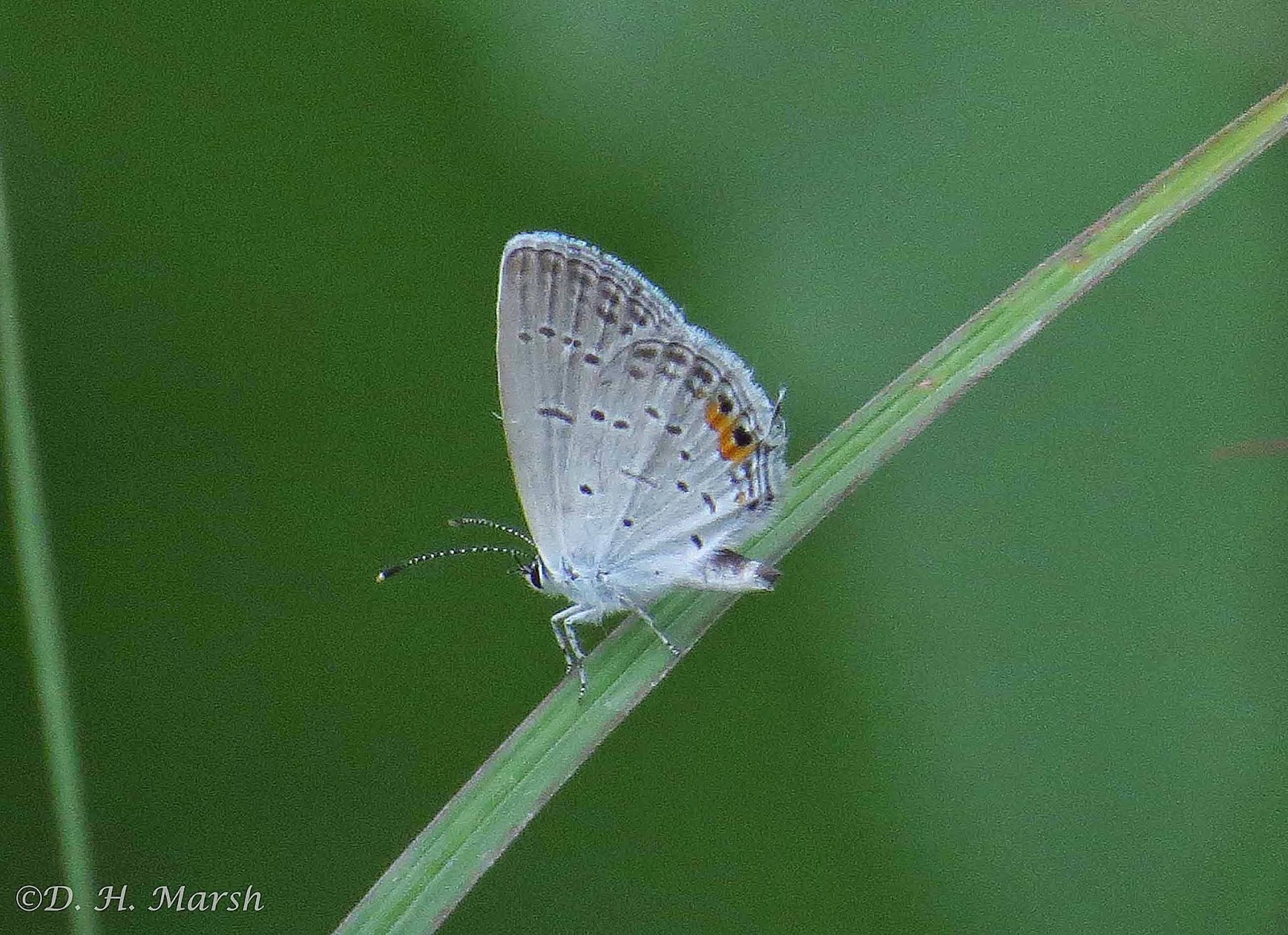One of our first stops was an interesting preserve that has several pocket prairie areas that support many rare plants. Along the trail we were excited to find a butterfly that was new for us, the northern metalmark:
Notice the metallic "threads" that give this tiny butterfly its name! Its upper side is beautiful, and the underside is equally stunning with its bright orange color and intricate pattern, plus cool green dashes:
Northern metalmark caterpillars feed on a plant called round-leaved ragwort, which is abundant in the area where we found three of the adults. We saw it in bloom several weeks ago.
Some of the other butterflies we saw here included the northern pearly eye:
and the tiny eastern tailed blue:
We were interested to see this unusual plant called the climbing milkvine--milkvines are in the milkweed family but are not in the same genus as the milkweeds:
After that hike we headed to Adams Lake State Park, a perfect site for a shady picnic. Refreshed and rehydrated, we did the very short hike at Adams Lake State Nature Preserve, another pocket prairie that hosts a variety of unusual flora and fauna.
American ipecac was in bloom; supposedly Native Americans used it as an emetic but it is not the source of the ipecac that is given these days to induce vomiting in the case of accidental poisoning (that comes from the roots of a South American plant):
American ipecac was in bloom; supposedly Native Americans used it as an emetic but it is not the source of the ipecac that is given these days to induce vomiting in the case of accidental poisoning (that comes from the roots of a South American plant):
A main attraction at this preserve is the Edward's hairstreak butterfly, which we didn't see when we were there last week. Today was a completely different story, and we saw at least 25 individuals! Most were nectaring on orange milkweed, often called butterfly weed:
Edward's hairstreak has a really unusual life cycle. Eggs are laid in bark crevices of young oak trees, and after they hatch the caterpillars live in huge anthills built by Allegheny mound ants:
At night, the ants accompany the caterpillars to small oak trees where the cats feed, protected by the ants from predators such as small parasitic wasps. This shingle oak, growing next to one of the ant mounds, would be a likely food source:
I am not making this up! The caterpillars exude a sweet substance called honeydew that the ants consume, and thus it is a mutually beneficial relationship. The adults only last a few weeks, but right now they are abundant in this location.
We didn't see many of the ants, probably because it was so hot that they were inside their mound. But we did spot a dragonfly, a beautiful female eastern pondhawk, eating an ant--the circle of life, indeed!
We didn't see many of the ants, probably because it was so hot that they were inside their mound. But we did spot a dragonfly, a beautiful female eastern pondhawk, eating an ant--the circle of life, indeed!
In addition to the Edward's hairstreaks, great spangled fritillaries were taking advantage of the nectar offered by the orange milkweed:
We made one last stop before heading home, and that was Chaparral Prairie State Nature Preserve. In a few weeks this area will be full of blooming prairie plants such as rattlesnake master, crownsbeard and prairie dock, but today we enjoyed seeing lots of orange milkweed plus whorled loosestrife:
and purple milkweed:
We were even treated to a view of a fairly unusual butterfly, the hoary edge, which was perched atop a prairie dock leaf. It is named for the frosted-looking edging on its hindwing:
A brief stop at a UDF for ice cream was a welcome relief from the heat, and we all agreed that this trip had been a great way to spend a summer day!
By the way, it has been a little while since I posted on this blog, mainly because we have been busy exploring. If you'd like to read more about what we've been up to, check out botanist Andrew Gibson's excellent blog here and here to find out about one of our recent adventures!
By the way, it has been a little while since I posted on this blog, mainly because we have been busy exploring. If you'd like to read more about what we've been up to, check out botanist Andrew Gibson's excellent blog here and here to find out about one of our recent adventures!














Fascinating story of the ants and the caterpillars -- thanks! All your butterfly photos are amazing.
ReplyDelete